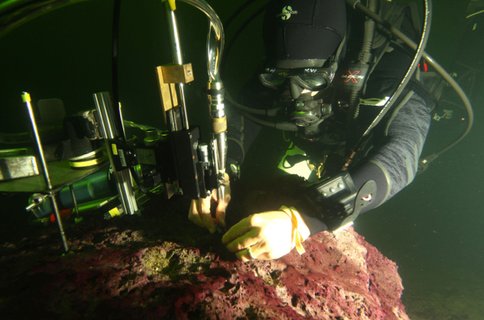2014 Annual Science Report
 Pennsylvania State University
Reporting | SEP 2013 – DEC 2014
Pennsylvania State University
Reporting | SEP 2013 – DEC 2014
Biosignatures of Life in Ancient Stratified Ocean Analogs
Project Summary
Instigated by Macalady and Kump in 2010, this project investigates biosignatures of life in modern analogs for stratified ancient and/or extraterrestrial oceans. The primary field site is a sinkhole in Florida. Other field site include stratified ocean analogs in the Bahamas, New York State, and the Dominican Republic. A website monitoring the activities of an informal working group on Early Earth Photosynthesis is maintained by Macalady (http://www.geosc.psu.edu/~jlm80/EEP.html).
Project Progress
Little Salt Spring
A Proterozoic-analog microbial ecosystem was discovered at Little Salt Spring (FL) in 2011 and has unique potential to help us understand biosignatures of earth evolution, specifically the long delay in the continued oxidation of the surface earth after the initial rise at the Great Oxidation Event (GOE, ~2.4 Ga). The sinkhole is weakly stratified and has low concentrations of oxygen, sulfide and sulfate throughout the water column, similar to the geochemistry hypothesized for Proterozoic oceans. The sinkhole hosts a mixed oxygenic/anoxygenic community of microbial phototrophs. This site thus provides an opportunity to investigate biogeochemical and microbial processes in a Proterozoic ocean analog, including the ecological and geochemical controls on oxygen production and organic matter preservation. In addition, the microbial ecosystem at the site produces large quantitites of hopanoids, an important class of organic biomarkers that can be preserved in rocks for billions of years.
A second major field campaign in early Nov. 2014 was spearheaded by Macalady’s group in collaboration with two scientists from the Max Planck Institute for Marine Microbiology in Bremen, Germany, and two European scientific and technical divers from the Hydra Institute who are experts in the underwater deployment of microsensors. Microsensor measurements were carried out both for in situ microbial mats and mat samples maintained in the field lab at the site. These data are currently being used as input to a redox and oxygen budget for the mat ecosystem.
Publications
-
Hamilton, T. L., Bovee, R. J., Thiel, V., Sattin, S. R., Mohr, W., Schaperdoth, I., … MacAlady, J. L. (2014). Coupled reductive and oxidative sulfur cycling in the phototrophic plate of a meromictic lake. Geobiology, 12(5), 451–468. doi:10.1111/gbi.12092
-
PROJECT INVESTIGATORS:
-
PROJECT MEMBERS:
Jennifer Macalady
Project Investigator
Katherine Freeman
Co-Investigator
Trinity Hamilton
Co-Investigator
Lee Kump
Co-Investigator
James Fulton
Collaborator
Jeff Havig
Collaborator
Rebecca McCauley
Collaborator
Rebecca McCauley
Collaborator
Katja Meyer
Collaborator
Roger Summons
Collaborator
Miriam Weber
Collaborator
Paula Welander
Collaborator
Dirk de Beer
Collaborator
-
RELATED OBJECTIVES:
Objective 2.1
Mars exploration.
Objective 3.3
Origins of energy transduction
Objective 3.4
Origins of cellularity and protobiological systems
Objective 4.1
Earth's early biosphere.
Objective 5.2
Co-evolution of microbial communities
Objective 5.3
Biochemical adaptation to extreme environments
Objective 6.1
Effects of environmental changes on microbial ecosystems
Objective 7.1
Biosignatures to be sought in Solar System materials
Objective 7.2
Biosignatures to be sought in nearby planetary systems
